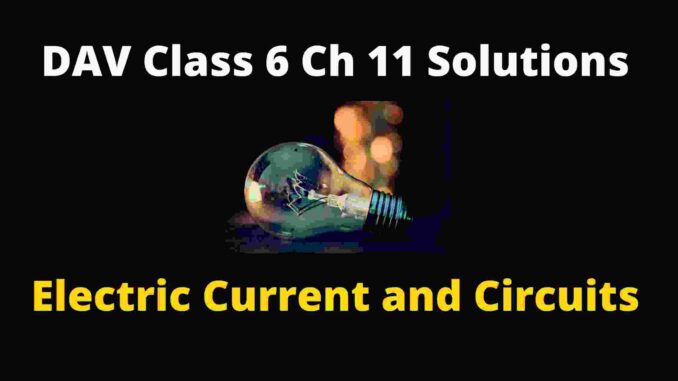
Electric Current and circuits are an important topic of class 6 Science. This chapter discusses the electric current, the circuits and the components of a circuit. Conductors, insulators and other materials. Let us check out DAV Class 6 Science Chapter 11 Solutions with explanation.
DAV Class 6 Science Chapter 11 Solutions
A. Fill in the blanks.
1. The thin coiled wire, that gives light, when heated up, is known as the ___________ of an electric bulb.
2. An electrical device needs at least ___________ terminals.
3. An electric bulb glows when a ___________ flows through it.
4. The device, that is used to ‘break’ or ‘make’ an electric circuit, is called an ___________.
5. The materials, which (easily) let electricity flow through them, are called ___________.
6. Electric current ___________ pass through a sheet of plastic.
Answer:
(1) filament
(2) two
(3) current
(4) electric switch
(5) conductors
(6) does not
B. Write True or False for the following statements.
1. A dry cell stops working when the chemicals in it get used up.
Ans. True
2. Electric current is taken to flow from the negative terminal of the (electric) cell to the positive
False
3. We need to complete the relevant electric circuit to enable an electric device to work.
Ans. True
4. Button cells are used in wrist watches.
Ans. True
5. We can use a polyster thread, in place of metal wires, to complete an electrical circuit.
Ans. False Explanation: We need metals for the flow of electric current.
C. Tick the correct option.
Answer:
(1) filament
(2) filament gets heated up and then starts emitting light.
(3) a source of electric current, a few conducting wires as well as an electric switch.
(4) both switches 1 and 2 are in their ‘ON’ positions.
(5) option B
Also Check: Separation of Substances Question Answers DAV Class 6 Science
D. Answer the following questions in brief.
1. State the function of the metallic strips used in a torch?
The metallic strips used in the torch act as conducting wires.
2. The given diagram shows a dry cell with its different parts marked as 1, 2, 3, 4 and 5. Which of them are the ‘two terminals’ of the dry cell?
Ans.
- 1-metal cap (positive)
- 5-Zinc case (negative)
3. Write the meaning of the term ‘electric circuit’?
Electric circuit is a set up made of metal wires, bulb, switch etc. It si basically a path through which electric current flows.
4. State the role of an electric switch in an electric circuit.
Ans: The electric switch stops or start the flow of electric current in a given circuit. When the switch is closed position the current flows, when the switch is on position, the current flow stops.
Don’t Miss: DAV Class 6 Science Chapter 2 Solutions
5. Tools, like screw drivers and pliers, used by electricians, have handles made up of, (or covered with) plastic, rubber or wood. Why?
Ans: The tools like screwdrivers and pliers are made up of plastic, rubber or wood because the substances are poor conductors of electricity. They protect the electricians from any kind of shock. They are known as insulators.
6. Why should we always dry our hands before touching an electric appliance, or a switch?
We should dry our hands before touching an electric appliance because the water may conduct electricity and can cause a shock to the person touching the appliance. Dry hands will prevent us from shock.
E. Answer the following questions.
1. Write in brief, the working of an electric torch.
A torch has two cells, a bulb and a sliding switch. When we slide the switch in ON position electric current starts flowing through the circuit to the bulb. The filament of the bulb heats up and the bulb starts glowing.
2. A student, while performing an experiment in the science laboratory, connected an electric bulb to an electric cell through an electric switch. He noticed that the bulb did not glow when the electric switch was set in its ON position. Mention ‘any two reasons for this observation.
There can be various reasons for this observation
- The bulb may have fused
- The cell may have dried up. He should try using another cell.
A loose circuit can also be one of the reason.
3. Separate out the devices, listed below, into categories that usually work with (i) either batteries or mains (ii) batteries only (iii) mains only.
kettle, iron press, calculator, toaster, mobile phone, washing machine, radio, transistor, computer, microwave oven.
Ans: i) either batteries or mains: Computer
ii) Batteries only: Mobile, calculator, Radio, Transistor
iii) Mains Only: Iron press, kettle, toaster, microwave oven, Washing machine etc.
4. Match the labels to the correct parts of the circuit given below. Will this circuit work? Justify your answer.
The circuit will not work because the switch is not in the ON position.
5. Distinguish between the term’s conductors and insulators of electricity. Give two examples of each type.
Answer:
Conductors: Materials that allow electricity to pass through them easily are called conductors.
Examples – Aluminium, copper.
Insulators: Materials that do not allow electricity to pass through them, are called Insulators.
Examples- Rubber, plastic.
So, these were solutions to Electric Current and Circuits Question Answers. If you have any doubt in DAV Class 6 Science Chapter 11 solutions, feel free to ask me in the comments section. Stay tuned to CareerAdvice4u.com and don’t forget to subscribe to the web push notifications.

Leave a Reply